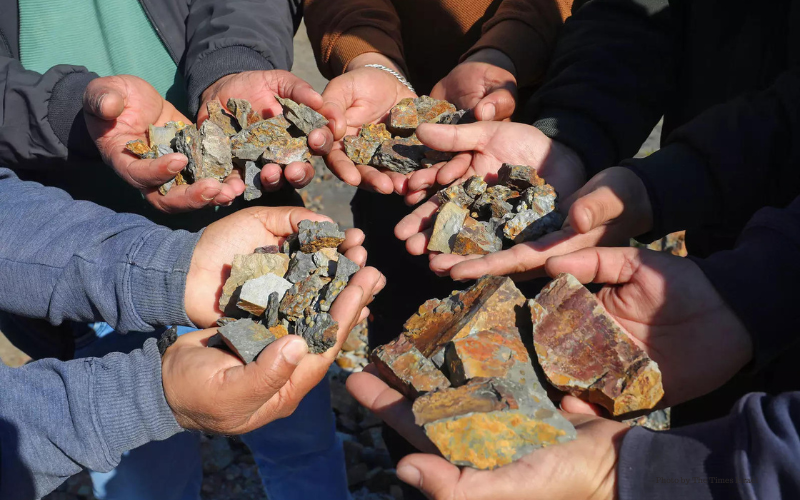Lithium is flowing from the Global South to the Global North, powering a massive electrification effort in high-income countries, particularly due to its criticality in electric vehicle (EV) batteries. However, this silvery metal is not a silver bullet. Lithium mining comes with high environmental and social costs to the land and local population, disproportionately harms indigenous communities, and contributes to biodiversity loss. Underpinning the present framing of the climate crisis is an internal tension: lithium is necessary to drive the energy transition, but it is actively contributing to localized destruction.
Many high-income countries view EVs and broader electrification not only as a way to meet their climate goals but also as a key step to securing energy independence, more critical than ever as the War in Ukraine has upended the natural gas market. Many of these same countries lack domestic lithium production, and governments and companies are scrambling to secure lithium supply chains now, as the International Energy Agency projects an increase in global lithium demand of 42 times by 2040. Amidst this modern-day gold rush, two critical questions must be examined about the sustainability of lithium mining and the EV business.
Will there be enough lithium to meet demand?
The short answer is no, at least under the current approach in EV planning. Policies like the Inflation Reduction Act, and President Joe Biden’s landmark climate bill, provide incentives for EVs, spearheading a push to replace traditional gasoline-based cars. A one-for-one replacement of internal combustion engine (ICE) vehicles with EVs will require far too much lithium, and even scaling up the industry will not prevent bottlenecks in supply. Boston Consulting Group (BCG) projects a supply gap of 1.1 million metric tons by 2030, 24% less than demand. Many pledges for EV growth ignore this reality. Our car-centric societies are not sustainable, even as they get increasingly electrified. Greater benefits can be achieved by investing in public transportation and increasing the ability to survive without a car.
To preserve a livable planet, society must be transformed at many levels. The International Energy Agency estimated that global EV annual sales must reach 47 million by 2030 to align with its sustainable development scenario. However, even reaching 28 million sales annually by 2030 would require a sixfold increase in lithium production. For humanity to avert the worst effects of the climate crisis, it either needs an outlandish increase in the production of a scarce resource, or it needs to change how it organizes its communities fundamentally. Basic concepts like the 15-minute city, more reliable public transport, and more interconnected rail systems have the power to reduce automobile demand radically. For example, Paris has successfully cut car use by 45% by reducing areas designed for cars and reclaiming them as public spaces. By looking under the hood of the vehicle electrification movement, it’s clear that only a multifaceted approach can prevent a lithium shortage from stalling all progress toward key climate goals.
Can lithium be mined sustainably?
Gabriel Boric, the Chilean President, says yes. In April 2023, Boric announced plans to nationalize the lithium industry. Part of Boric’s plan attempts to address the sustainability of the lithium industry, by advancing direct lithium extraction (DLE) to a commercial scale. Evaporation is the primary process employed in Chile, the second-largest producer of lithium in the world. To do this, brine, a saltwater mixture containing lithium, is pumped into massive, shallow pools, where evaporation slowly leaves behind lithium. This uses huge amounts of water in the Atacama Desert, which can hardly afford any wasted water. The indigenous Colla community’s ancestral lands have been eroded and dried up due to lithium mining, and members fear that those still living in the mountains will be forced to move to the urban center of Copiapó. The loss of the Laguna de Santa Rosa, a nearby wetland, threatens the 17 endangered species that live there, as well as the migratory birds that stop by.
Boric’s plan to nationalize the lithium industry provides the opportunity to mitigate the externalities of the mining practice. DLE extracts lithium directly from the brine, using less water and land than evaporative pools, while recovering a greater percentage of lithium in less time. Naturally, there is a catch. DLE has never been implemented at a large scale before, and the data is less clear on costs than the proven method of evaporative pools.
Boric is staking his country’s lithium future on untested technology. Nevertheless, this switch, if it proves effective in practice, could protect indigenous communities and biodiversity. His is also a measured nationalization, with an emphasis on public-private partnerships and respect for existing contracts. With lithium fever and few options, companies, and investors are unlikely to flee the country; they may not find more favorable opportunities elsewhere. This resource power gives Boric the latitude to shift lithium production in a sustainable direction, and, if successful, this can provide a roadmap for other countries to develop their lithium industry, particularly Bolivia, which sits on the world’s largest lithium reserves.
Path forward
Electrification is a critical step towards a carbon-free economy, making lithium immensely important for the clean energy transition. Done carelessly, the mad rush for lithium will cause severe environmental and social impact, while still failing to keep up with accelerating demand. Only a multi-sectoral response focused on curbing lithium demand through a commitment to public transport and achieving buy-in from local communities by reducing the impact of lithium extraction will allow the economy to adapt sustainably.



